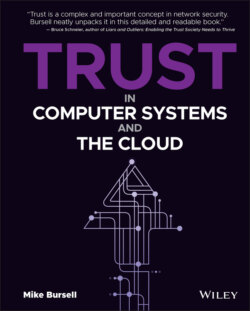Читать книгу Trust in Computer Systems and the Cloud - Mike Bursell - Страница 11
Analysing Our Trust Statements
ОглавлениеThe four cases of trust relationships that we have noted may look similar, but there are important differences that will shed light on some important concepts to which we will return throughout the book and that will help us define exactly what our subject matter is.
Case 1: My Trusting My Brother and Sister As we have already discussed, this statement is about trust between individual humans—specifically, my trust relationship to my brother, and my trust relationship to my sister. There are two humans involved in each case (both me and whichever sibling we are considering), with all of the complexity that this entails. But we share a set of assumptions about how we react, and we each have tens of thousands of years of genetics plus societal and community expectations to work out how these relationships should work.
Case 2: My Trusting My Bank Our second statement is about trust between an individual and an organisation: specifically, my trust relationship to a legal entity with particular services and structure. The basis of the expression of this relationship has changed over the years in many places: the relationship I would have had in the UK with my bank 50 years ago, say, would often have been modelled mainly on the relationship I had with one or more individuals employed by the bank, typically a manager or deputy manager of a particular branch. My trust relationship to the bank now is more likely to be swayed by my views on its perceived security practices and its exercising of fiscal and ethical responsibilities than my views of the manager of my local branch—if I have even met them. There is, however, still a human element associated with my relationship, at least in my experience: I know that I can walk into a branch, or make a call on the phone, and speak to a human.3
Case 3: The Bank Trusting Its IT Systems Our third statement is about an organisation trusting its IT systems. When we follow our new resolution to rephrase this as “The bank having a trust relationship to its IT systems”, it suddenly feels like we have moved into a very different type of consideration from the initial two cases. Arguably, for some of the reasons mentioned earlier about interacting with humans in a bank, we realise that there is a large conceptual difference between the first and second cases as well. But we are often lulled into a false sense of equivalence because when we interact with a bank, it is staffed by people, and it also enjoys many of the legal protections afforded to an individual. There are still humans in this case, though, in that we can generally assume that it is the intention of certain humans who represent the bank to have a trust relationship to certain IT systems. The question of what we mean by “represent the bank” is an interesting one when we consider when we might use this phrase in practice. Might it be in a press conference, with a senior executive saying that the bank “trusts its IT systems”? What might that mean? Or it could be in a conversation between a regulator or auditor with the chief information security officer (CISO) of the bank. Who is “the bank” that is being referred to in this situation, and what does this trust mean?
Case 4: The IT Systems Trusting Each Other As we move to our fourth case, it is clear that we have transitioned to yet another very different space. There are no humans involved in this set of trust relationships unless we attribute agency to specific systems; and if so, which? What, then, is doing the trusting, and what does the word trust even mean in this context? The question of agency raised earlier—about an entity representing someone else, as a literary agent represents an author or a federal agent represents a branch of government—may allow us to consider what is going on. We will return to this question later in this chapter.
The four cases we have discussed show that we cannot just apply the same word, trust, to all of these different contexts and assume that it means the same thing in each case. We need to differentiate between them: what is going on, who is trusting whom to do what, and what trust in that instance truly means.
